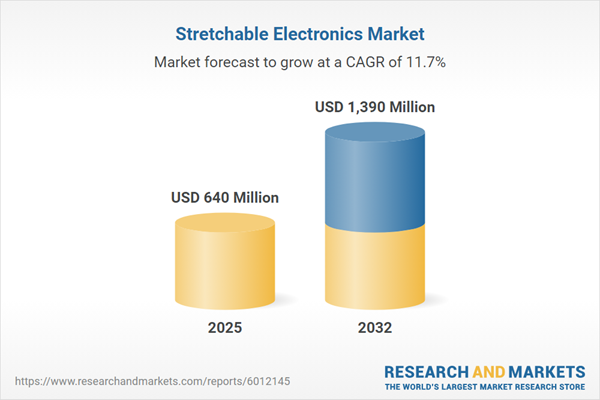Speak directly to the analyst to clarify any post sales queries you may have.
The stretchable electronics market is accelerating industry transformation, positioning senior decision-makers to drive innovation, operational agility, and digital competitiveness amidst evolving technological demands. Staying ahead of advancements in this area is integral to shaping flexible, responsive strategies in rapidly changing business landscapes.
Market Snapshot: Stretchable Electronics Market Growth and Outlook
The global stretchable electronics market is experiencing robust growth, set to expand from USD 576.63 million in 2024 to USD 640.00 million by 2025, with projections reaching USD 1.39 billion by 2032. This momentum is propelled by developments in flexible substrates, advances in stretchable sensors and devices, and strong collaboration among technology innovators and research institutions. Notable adoption is seen in healthcare, energy generation, and consumer electronics, where stretchable solutions are enabling applications such as patient monitoring, wearable analytics, and next-generation industrial processes. Strategic partnerships between commercial and research entities continue to advance commercialization and shorten development cycles, strengthening innovation across the value chain.
Scope & Segmentation: Strategic Segments in the Stretchable Electronics Market
This report offers executive-level insights for aligning organizational outcomes with evolving stretchable electronics trends. It dissects the market via comprehensive segmentation to uncover new opportunities and assess emerging challenges across global industries:
- Component: Stretchable batteries are fundamental for reliable power in flexible devices; flexible circuits boost system integration where conventional designs are limiting; adaptive displays enhance end-user interfaces in dynamic settings; advanced sensor arrays bolster real-time responsiveness in critical environments across healthcare and industry.
- Material Type: Conductive polymers underpin high electrical performance, especially within wearables and dynamic devices. Elastomers offer flexibility and repeated-use durability, vital in healthcare and consumer technology deployments.
- End-User Industry: Stretchable electronics serve sectors including consumer electronics, medical technology, aerospace and defense, telecommunications, and energy—each with sector-specific regulatory, operational, and innovation requirements influencing adoption and deployment.
- Application: Ranging from bio-integrated health monitoring to enhanced prosthetics and advanced wearable analytics, applications provide cross-industry utility and support adaptable business models for emerging markets.
- Regions Covered: The Americas, Europe, Middle East and Africa, and Asia-Pacific each bring distinct market dynamics in terms of adoption rates, research strengths, and partnership networks, shaping how technologies are introduced and scaled.
- Companies Profiled: Key organizations include AUO Corporation, E Ink Holdings Inc., LG Corporation, Panasonic Corporation, and Voltera Inc., each playing significant roles in commercialization strategy and in driving new alliances throughout the market.
Key Takeaways for Decision-Makers
- Emerging materials like conductive elastomers and sophisticated nanocomposites are improving integration of stretchable electronics into medical and industrial solutions, supporting product versatility across target sectors.
- Cutting-edge fabrication approaches, such as inkjet deposition and advanced lamination, are enabling more agile manufacturing and smoothing the path between design and market rollout.
- Collaboration between industry and research institutions remains central to technical validation and commercialization strategies, enabling organizations to remain adaptable in a competitive landscape marked by swift technological evolution.
- Supply chain strategies that prioritize vertical integration and diversified sourcing help mitigate risks, maintaining operational stability despite global market shifts and policy changes.
- Widespread adoption of embedded sensors and flexible displays is accelerating digital transformation, enabling enhanced data analytics and smarter decision-making for organizations in both emerging and established markets.
Tariff Impact: Navigating New U.S. Trade Policy
Forthcoming adjustments in U.S. tariffs for 2025 are prompting companies to reevaluate sourcing, procurement, and supply chain strategies. Enterprises are increasing focus on domestic sourcing, broadening their raw material supplier base, and strengthening vertical integration. These efforts are designed to maintain cost control and supply resilience, equipping organizations to remain steady as global trade conditions evolve.
Methodology & Data Sources
This report leverages primary industry interviews, sector-specific research, and in-depth reviews of regulatory frameworks. Executive perspectives and structured assessments, including SWOT and PESTLE analyses, further reinforce the validity and actionable nature of the findings.
Why This Report Matters
- Delivers actionable insights into technology trends and segmentation, giving senior leaders a strong foundation for investment, partnership, and innovation strategies.
- Equips organizations with an understanding of regulatory and supply chain complexities, supporting proactive procurement decisions and risk mitigation efforts.
- Benchmarks collaborative frameworks and leading practices, helping firms build resilience and competitive value as the market landscape shifts.
Conclusion
Continued evolution in stretchable electronics offers organizations adaptive capabilities and improved efficiency. Focused innovation in materials and supply chain coordination will be essential for achieving sustainable growth and stronger market positioning.
Additional Product Information:
- Purchase of this report includes 1 year online access with quarterly updates.
- This report can be updated on request. Please contact our Customer Experience team using the Ask a Question widget on our website.
Table of Contents
3. Executive Summary
4. Market Overview
7. Cumulative Impact of Artificial Intelligence 2025
Companies Mentioned
The companies profiled in this Stretchable Electronics market report include:- AUO Corporation
- Dycotec Materials Ltd.
- E Ink Holdings Inc.
- LG Corporation
- SENSING TEX, SL
- Covestro AG
- DZP Technologies
- EPTANOVA S.R.L.
- Liquid Wire Inc.
- Meiban Group Pte Ltd.
- Murata Manufacturing Co., Ltd.
- Panasonic Corporation
- Voltera Inc.
- Würth Elektronik eiSos GmbH & Co. KG
- Yole Group
- PCBMay by MV Circuit Technology Co., Limited
Table Information
| Report Attribute | Details |
|---|---|
| No. of Pages | 185 |
| Published | November 2025 |
| Forecast Period | 2025 - 2032 |
| Estimated Market Value ( USD | $ 640 Million |
| Forecasted Market Value ( USD | $ 1390 Million |
| Compound Annual Growth Rate | 11.7% |
| Regions Covered | Global |
| No. of Companies Mentioned | 17 |









